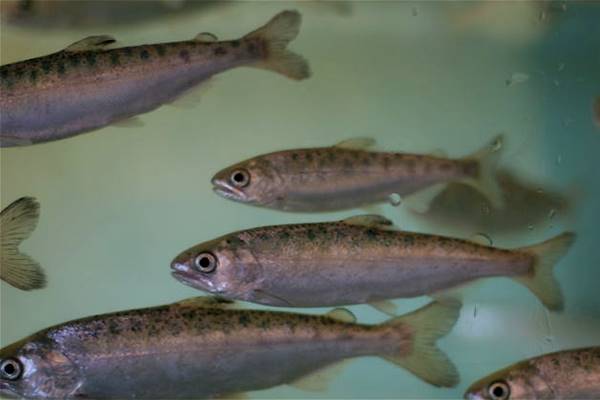Large-Scale Habitat Restoration Proves Beneficial for Juvenile Coho Salmon
 Coho smolts. (Credit: Cacophony via Wikimedia Commons CC BY 3.0))
Coho smolts. (Credit: Cacophony via Wikimedia Commons CC BY 3.0))Reports of salmon populations declining across North America have dominated news reports over the past few years—and there’s a genuine reason to be concerned about the declines. Not only are salmon a major food source for local communities, but they also are part of a rich cultural history. The decline in salmon population affects more than just human populations; salmon are a keystone species, meaning that the loss or significant decline of the species would drastically impact the ecosystem around them.
Studying Coho Salmon in the Upper Chilliwack River Watershed
Despite their significance, humanity has not always made the best effort to protect salmon. In Canada, decades upon decades of logging may have made the country the second-largest exporter of wood products, but it also left its mark on the environment. The price of such productivity became apparent in the late 20th century, when logging led to environmental damage that prompted Canada’s Department of Fisheries and Oceans to conduct a four-year restoration project in the upper Chilliwack River Watershed.
“The watershed in the study area was extensively logged during the 20th century, which increased landslide frequency and river bank instability and reduced large wood debris in fish habitat,” said Matt Foy, former restoration biologist at DFO. Foy is a co-author of a study published in the Canadian Journal of Fisheries and Aquatic Sciences which examines the effectiveness of the Forest Renewal Project that took place between 1996 and 2000. Focusing on coho salmon productivity, the study is among the first of its kind to evaluate restoration outcomes on a watershed scale.
“The restoration work increased floodplain off-channel habitat along the Chilliwack River valley,” Foy said. “Off-channel habitat is critical for juvenile coho salmon survival, particularly during the winter flood period.”
The goal of the study was to test whether the project effectively raised wild coho salmon productivity at a rate and cost comparable to hatchery production. To do so, they needed to estimate the coho smolt population in the upper Chilliwack River Watershed, and the proportion of that population originating from the restored off-channel waterways.
Two years after the Forest Renewal Program wrapped up, the researchers set up traps throughout the Chilliwack River system to capture coho smolts during their spring migration. Captured smolts were marked and released and, in many cases, recaught at a downstream rotary screw trap.
These tagged salmon could eventually be caught later on to provide data on recruitment rates in the region. Species recruitment refers to the transition very small juvenile fish undergo when they become older, larger fish.
“It was challenging to operate a trap in the Chilliwack River, a large, steep, boulder-bedded mountain stream,” Foy said. “Especially during the latter timing periods when the high-level snow melt got underway.” He noted that all the sites were located in forests, which posed several other minor challenges for the researchers.
Comparing data from the trapping project with area-based models built from previous studies, the researchers found that restoration improved coho smolt production. Furthermore, production in the most cost-effective restoration sites was comparable to average hatchery production costs. This is good news for future restoration projects, for which funding often hinges upon proof of fiscal efficiency.
“The study confirmed that floodplain restoration is a viable tool for recovering wild coho productivity in rivers degraded by human activities such as logging,” Foy said. He called the findings “encouraging due to the scale and scope of the works.”
Conclusion
Foy retired from Canada’s DFO in 2015 but has continued working to restore salmon habitats, spread information and educate the next generation of researchers. The self-proclaimed “salmon habitat nerd,” has dedicated a great deal of his time to volunteering for groups like the Pacific Salmon Foundation and the Fraser Valley Watersheds Coalition. Furthermore, Foy can be found on YouTube, where he’s posted several videos teaching about salmon habitat restoration.
Foy’s commitment to salmon habitat restoration after over 35 years of working for Canada’s DFO speaks to the importance of his work. Salmon are incredibly important to the surrounding ecosystem, making the restoration of their habitats all that more important and an easy thing to dedicate one’s life to protecting.



0 comments